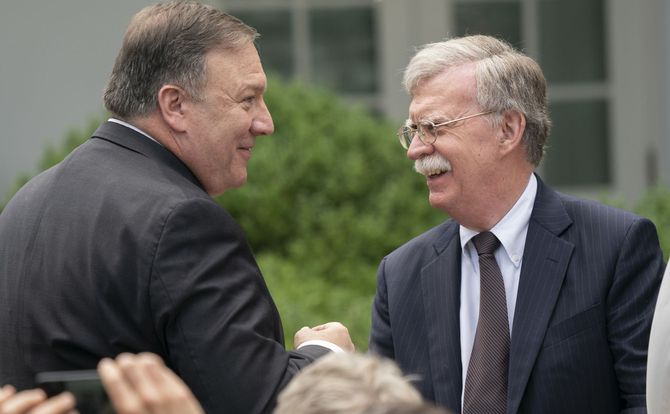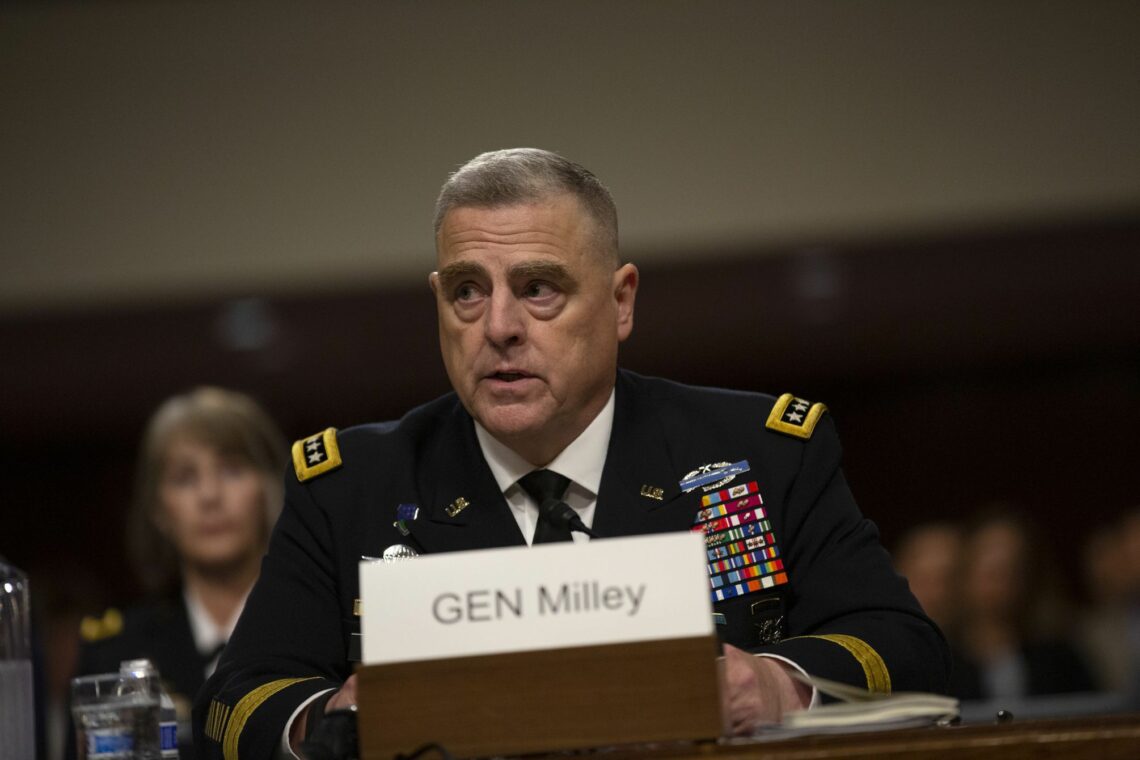The age of U.S. interventionism may not be over
President Trump has made it clear he wants to avoid military interventions but has shown a readiness to use force when necessary. America’s most significant competitors also want to avoid military confrontation. However, others could find benefit in drawing the U.S. into a fight. Events around the world could yet force the president’s hand.

In a nutshell
- President Trump prefers a noninterventionist policy
- When he does use military force, it is non-escalatory
- Events around the world could force a change of course
Ever since the September 11, 2001 terrorist attacks, robust interventionism has been a hallmark of the United States’ foreign policy. This was reflected in the administrations of both Presidents George W. Bush (2001-2009) and Barack Obama (2009-2017). The current U.S. president, Donald Trump, has professed an aversion to interventionism.
Nevertheless, some of his key advisors have strongly advocated such policies in the past. Further, in this new age of “great power competition” – as described by the Trump administration itself – the opportunity for conflict could escalate. Simply put: the U.S. is a global power, with worldwide interests. So, while Washington’s policy is to eschew military engagements, interventions cannot be excluded.
Republicans and Democrats
Muscular intervention is commonly associated with presidential administrations led by a member of the Republican Party. The historical record, however, is far more mixed. Advocacy for the proactive use of coercive force is not particular to any American political party. The presidency of Republican Dwight Eisenhower (1953-1961), for instance, was marked by interventions in Latin America, most notably the CIA-sponsored operation in Guatemala. President Eisenhower demurred from intervening during the Hungarian Revolution (1956) and opposed Franco-British intervention during the Suez Crisis (1956). Presidents John F. Kennedy (1961-1963) and Lyndon Johnson (1963-1969), both Democrats, authorized numerous interventions, including escalating U.S. engagement in the Vietnam War.
Advocacy for the proactive use of coercive force is not particular to any American political party.
More recently, the administration of Republican President George W. Bush was noteworthy for its foreign interventions, especially the wars in Afghanistan (2001) and Iraq (2003). Both were followed by protracted, bloody postwar conflicts in which the U.S. engaged.
President Obama, a Democrat, also had his share of military adventurism. After his election, Mr. Obama reduced U.S. involvement in Afghanistan and withdrew American forces from Iraq. On the other hand, he directed U.S. forces to participate in NATO-led military operations in Libya (2011) and reintroduced U.S. forces in Iraq to help combat the Islamic State (also known as Daesh or ISIS).
No isolationist
President Trump was elected in 2016 under the slogan “America First,” which many associated with the isolationist movement that pushed to keep the U.S. out of World War II. Mr. Trump quickly proved that he was not an isolationist. He ordered missile strikes against Syrian forces as retaliation for their use of chemical weapons in 2018. He also authorized the U.S. military’s continued support for operations in Afghanistan and expanded its activities against ISIS in Syria.
On the other hand, after taking office, President Trump frequently indicated he did not prefer military intervention and, in particular, denounced operations fostering “regime change” and “nation-building” as costly and unnecessary. In 2017, the administration published its National Security Strategy, which reflected many of these themes.

Under President Trump, U.S. military operations have mainly been consistent with that strategy. While the administration argues for “peace through strength,” building up military capability to deter conflict, the U.S. has been reluctant to undertake additional combat missions. For instance, the U.S. has held back from reengaging in Libya. The administration has drawn down forces in Syria and launched a diplomatic effort to broker peace between the Taliban and the Afghanistan government.
The U.S. did not seek to escalate conflict after North Korea conducted a series of provocative nuclear and ballistic missile tests, despite heated rhetoric on both sides. It has also eschewed direct intervention in Venezuela, notwithstanding its continued opposition to the regime of Nicolas Maduro. More recently, the Trump administration chose not to respond with military force after Iran shot down a U.S. surveillance drone in the Persian Gulf. Washington has emphasized that it is not eager to enter into armed conflict against the regime in Tehran.
Showing resolve
On the other hand, the administration has shown it will not hesitate to use the U.S. armed forces to demonstrate American resolve. It has conducted robust freedom of navigation operations in the South China Sea and committed American forces to protect the right of passage through the Strait of Hormuz. The U.S. continues to assist missions in Iraq and Afghanistan, as well as maintain a small footprint in Syria.
The U.S. has increased sales of lethal arms to Ukraine to deter Russia.
Additionally, the U.S. continues to use arms sales, training, and other military assistance to build up other countries’ capabilities. Most notably, the U.S. has increased sales of lethal arms to Ukraine to deter Russia and announced a new round of arms trade with Taiwan to expand its capacity for self-defense.
Moreover, the administration has also looked to expand cooperative security. For example, it is largely credited with encouraging NATO allies to invest an additional $100 billion in defense. The U.S. has been pursuing a stronger strategic partnership with India and is trying to build a Middle East Security Architecture – a common security framework with states in the Gulf Cooperation Council.
Vocal advisors
Concerns over U.S. interventionism persist, however, mainly because some of the president’s closest advisors are vocal advocates of such policies. These include National Security Advisor John Bolton (who in the past has advocated for direct military action against Iran, North Korea and Somali pirates), Secretary of State Mike Pompeo and Republican Senators Lindsey Graham and Tom Cotton.
What is notable, however, is that many presidential advisors clearly do not favor interventionist policies, like media talk show host Tucker Carlson and Republican Senator Rand Paul. In practice, while President Trump draws counsel from many on foreign affairs issues, he does not appear to be captive to the recommendations of any particular advisor.
President Trump seems unafraid to use pressure to safeguard American interests, including the direct use of force.
U.S. policies have consistently been neither reckless nor risk-averse. President Trump seems unafraid to use pressure to safeguard American interests, including the direct use of force. Even when the president chooses to employ coercive power directly, he prefers to take non-escalatory measures: the operations are designed to achieve a specific, limited outcome.
Additionally, many of the competitors the U.S. has singled out in this new age of “great power competition” seem eager to avoid a military confrontation with the U.S. Russia, China, Iran and North Korea all have strategies that aim to avoid armed conflict with American forces. Instead, these countries focus on measures short of war to undermine, limit, or influence U.S. presence and policies.
Global interests
Still, the prospects of future U.S. military interventions cannot be ruled out. The U.S. is a global power, competing in many parts of the world, including areas that are politically fragmented and unstable. The U.S. may not want war with others, but there may be others who see value in confrontation with the U.S., including, for example, transnational terrorist organizations. Other powers might wish to engineer or sponsor conflict with the U.S. to distract Washington.
To that end, U.S. military forces continue to develop capabilities to support intervention or expeditionary military operations. The U.S. Army has poured more money into readiness for deployable forces overseas. The army has also made clear that it will take money from existing equipment programs to fund its new modernization priorities. Army Chief of Staff General Mark Milley said that to free up $30 billion over five years for modernization, the branch will have to “kill” 93 equipment programs and reduce 93 others. Modernization priorities include long-range precision missiles; next-generation combat vehicles; future vertical lift platforms; communications devices; air and missile defense; and soldier lethality. All these priorities increase the army’s ability to conduct operations across the spectrum of conflict.
The most likely scenario is that in the short term, certainly through the national elections in 2020, the U.S. will eschew military interventions where possible. If President Trump is reelected, regardless of who his advisors are in the second term, expect the U.S. to continue to pursue alternatives to regime change when dealing with adversaries. Given that U.S. interventions would more likely be in response to hostile acts rather than at Washington’s initiative, it is difficult to predict where American forces might intervene. Every theater has its own potential hot spots where President Trump might feel compelled to employ the armed forces to protect American interests. In Europe, the Western Balkans remain an area of concern. The U.S. is also closely watching North Africa and the Northern Triangle region in Central America.







